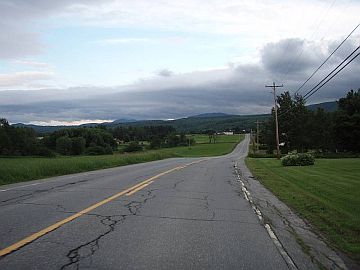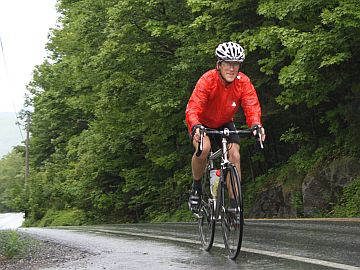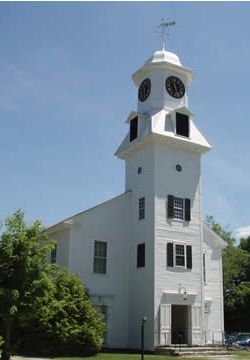| |
 |
| General Notes |
Ride Instructions
- Plan to be at the North Troy border station at 4:30 am Saturday, June 24th for a 5:00 am start.Sunrise is at 5:03 am, civil twilight begins at 4:25 am, if the sky is clear. Sunset is at 8:33 pm and it will be really dark by 9:09 pm, giving us over 15 hours of daylight to complete the ride. The old border station is just south of the new station. There are no public rest rooms or facilities at the border, so plan accordingly. Enhanced ID is necessary to cross the US border, and a standard driver license is no longer enough. If you wander north of the new border station and try to return without approved ID, you may find yourself sitting inside while the rest of the group is many miles down the road!
- Riders provide own transportation to start and from finish. Typically, this means finding a couple other people to ride with and someone to drive a sag vehicle. If you want to ride, but have no support, let us know and we'll do what we can to find someone with extra space. The best bet is to try reaching out to through our Facebook group. If you know you will have extra space, please let us know that too!
- Riders provide own support. We will not be collecting any funds for pooled supplies. There are plenty of stores on the route and support vehicles are expected to share water with all riders. Bring extra jugs. Experienced long-distance riders may find they can do the ride without external support.
- There are several B&Bs near the start where riders can stay the night before the ride. There are also a number of motels in Newport, which is about 30 minutes away from North Troy -- watch for deer! Staying near the border is highly recommended. It shortens what is already a very long day, makes it a lot easier on those driving sag, and helps everyone get to the start on time.
- NEW: One issue that seemed to create problems with motorists in past years was riders failing to single-up as vehicles stacked up behind them, especially in the first 20 miles. Support people later had to deal with a few irate drivers. Please be aware that Vermont state law allows bicyclists to ride two-abreast, as long as this does not impede the normal flow of traffic. Cyclists and motorists often interpret "impede the normal flow of traffic" differently, but it's clear that when there's traffic in both directions, or traffic behind when approaching a curve or the crest of a hill, riders need to promptly slide into single file formation, as close to the right as practicable. We don't want to annoy drivers uneccesarily, or spoil the day by waiting while an officer writes out a dozen traffic citations.
- Support vehicles should not follow a group slowly, blocking traffic, even with flashers on. Instead, leapfrog the riders, traveling down the road a distance before finding a safe, legal place to pull off and wait. Riders will often appreciate the opportunity to add or shed a garment in the first 5 to 10 miles, but after that, support vehicles might choose to go ahead 15 to 20 miles or more before waiting. Riders will arrive sooner than supporters expect and generally won't want to stop unless there's a scheduled break or something unexpected happens. Some supporters have come up with interesting approaches, such as parking 50 miles down the road and riding back to meet up with their riders.
- Most riders will want to form into dynamic groups, keeping in mind that there are no rules to this ride. Groups of varying abilities will typically form, break apart, and new groups form, based on terrain and how long people spend at breaks. Groups larger than 15 riders are generally considered unsafe. Please don't be offended if you get dropped. To paraphrase Vermont cyclist John Orlando, "It won't be Paris-Roubaix, but neither is it Oprah on a hybrid." The goal for most is to finish during daylight without killing ourselves. See the Training Tips page for advice on preparation. Many riders have completed this ride long after dark. We'll try to stay at the end until we think everyone who is going to finish has arrived, but we won't know if you are still out on the road as there is no sweep. Don't be glum if you find yourself riding alone, espcially in the second half of the ride. It often works out better when you can ride at your own pace. If you require moral support, talk a friend into riding with you and commit to staying together, even if that person finds that they have to "ride" some sections in a support vehicle. It can make a huge difference when you're riding with good friends.
- The actual ride time is typically 11-16 hours plus breaks, allowing most riders to finish during daylight. We've found it best to keep breaks short and relatively frequent, every 25-30 miles after the first 100. Breaks longer than 20 minutes leave you stiff and sore. Riders who skip breaks entirely can get ahead of support vehicles.
- Bring a tail light and headlight. Not only will it be helpful if you finish after dark, but a late afternoon rainstorm can make things plenty dark. Vermont law requires a front light (visible from 500') and 20 in2 of rear reflector or a taillight when riding at night. Reflective leg bands are also a good thing to bring along to add visibility. A standard rear reflector, by itself, does not meet the minimum rear reflective requirement in Vermont (10 sq in), but adding leg bands usually does. A taillight trumps reflectors, at least as far as the law is concerned.
- Most of the route lacks reliable cell phone coverage. Watch out for connections to Canadian cell towers near the border. The best cell coverage is near the I-89 interstate (Waterbury) and the seven ski areas that we pass by. (Jay, Stowe, Waitesfield/Warren, Killington, Ludlow, Londonderry & Dover) There is now cell coverage in Readsboro, but not three miles away at the finish.
- An approach that can make the ride easier for both a rider and the support driver is to split the ride, with the rider switching with the driver at the Rochester break. Keep in mind that the second half of the ride is tougher than the first.
- The event is rain or shine (or snow).
- Be prepared! The weather in Vermont can be anything. Cold rain in 2018 made long-fingered gloves and extra layers necessary for many riders to finish.
Can I ride without any outside support?
Sure! There's nothing that says that you need a support vehicle. The sport of randonneuring is based on self-supported riding. You may even be able to find a vehicle willing to transport your extra gear down to the Mass. border, but lots of things can happen, so don't leave yourself reliant on that gear after the ride. We'll do what we can, but remember that there is no guaranteed sweeping of the course, and much of the route lacks cell phone service, so self-supported means just that.
A Final Note
You might be thinking to yourself, “This is a strange ride. What are these people really offering?” There are all kinds of rides, from fully supported tours where a positive experience is guaranteed, to fleches, where only the destination, date, and a few arcane rules are established. This ride is somewhere low on that continuum. We are not guaranteeing you anything, other than we plan to be at the Canadian border at 4:30 am, June 22nd. We'll do what we can to organize the support vehicles, which mostly consists of keeping track of who is riding with who. We are not renting vans, setting up tents, providing food or support, reserving lodging, paying traffic tickets, or taking responsibility for you or your equipment. There are no fees for this ride, no special insurance policies, no sanctioning by any organization, no prizes and no rules. All we can guarantee is a ride you will talk about for the rest of your life.
|
|
| |
|

Morning sky outside North Troy

Crosby was first to the top of the Mt. Snow climb in 2009

Classic New England church in Weston

The Deerfield River at Readsboro
|
|



